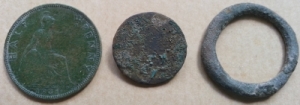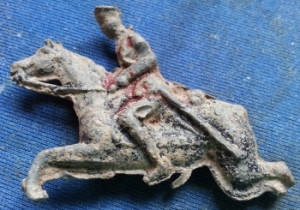I made a first visit this afternoon to the new 60 acres of pasture and spent about 3 hours there with the intention of just having a general wander about the field nearest to the farmhouse.
The first find of the day was a George V halfpenny dated 1931 which turned up in more or less the first hole I dug. It’s in nicer condition than appears from the photograph and virtually all of the detail is crisp. Only the most prominent parts of the union flag device on the shield show any signs of wear so it must have been lost not long after coming into circulation.
After about half an hour of detecting the Deus suddenly started to play up, chattering wildly. I had wandered close to the end of a minor or local power line and assumed this had upset it, but despite switching the control unit and the headphones off and on repeatedly the chattering kept on recurring. I must have switched it all off and back on again several dozen time, and at one point the control unit sent up the worrying message “No coil”. Some programs seemed to be worse affected than others, or rather programs Basic 1, Basic 2 and GMaxx (1, 9 and 5 respectively) seemed to be the least affected. I tried other areas of the field and kept switching programs to see what worked best but I found that if I laid the detector down for the minute or so it took to dig a hole it was chattering away again when I picked it up. I’m not sure what’s going on here, and really hope the coil is not about to pack up on me, but I will try it again in the garden and see about rolling back the software to v2 and then forward to v3 again in case something has been corrupted.
The only other finds worth mentioning were a modern button and yet another copper alloy ring of the belt ring or curtain ring variety. The stuff not worth mentioning (but I will anyway) included a strip of copper, a scrap of lead or pewter and a lump of coke.
The afternoon was uncomfortably warm and there were a few blood sucking insects about, especially under the line of trees along one edge of the field. I was also troubled by my knee which is still bloody painful to kneel on even using heavy duty knee pads. By the end of 3 hours and a dozen or more holes dug, it was very tender and I’m starting to wonder if it will be a couple of months yet (ie, the end of the summer) before it’s back to normal. 3 hours detecting seems to be my limit at present because of this.
Finds: 1 button, 1 George V 1931 halfpenny and 1 copper alloy ring.



